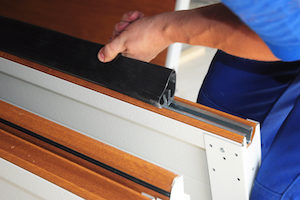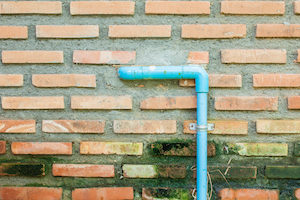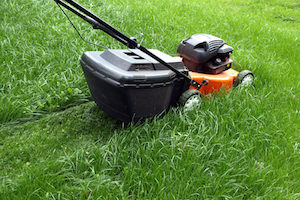If you’ve ever had a rodent in your home, you know how persistent they can be. You lay out traps, seal off cracks, and even call in pros, but year after year, there they are. It’s easy to get discouraged or even apathetic about the whole process. But not this year. This year things are going to go differently. This year you stop the rodents. We’re here to help.
Sound ambitious? It’s easier than you think! Just follow these four steps, and you’ll be well on your way to creating a rodent-proof environment. Don’t give up! Getting a jump start on this will give you the momentum you need to complete your other resolutions. It all starts here!
Replace Weatherstripping
 Weatherstripping is the long, rubber material that makes up the threshold between doors and windows and their frames. This stripping makes an airtight seal between the door or window and the outside air. Without it, outdoor air would slip through the cracks and enter your home. Over time, weatherstripping can wear down. Damaged weatherstripping may not keep outdoor air out, or it may peel away from the threshold all together. Either way, it provides a perfect opportunity for rats and mice.
Weatherstripping is the long, rubber material that makes up the threshold between doors and windows and their frames. This stripping makes an airtight seal between the door or window and the outside air. Without it, outdoor air would slip through the cracks and enter your home. Over time, weatherstripping can wear down. Damaged weatherstripping may not keep outdoor air out, or it may peel away from the threshold all together. Either way, it provides a perfect opportunity for rats and mice.
When outdoor air seeps in, the pressure difference between that air and indoor air creates a vacuum that sucks heat out. Rodents outside feel this heat escaping and follow it to its source: the damaged weatherstripping. Rats and mice can easily bite through or sneak under weatherstripping that’s already been damaged. Examine all the weatherstripping in your house and replace any that looks worn. You can buy inexpensive weatherstripping materials at most hardware stores.
Seal Utility Lines
 Mice only need an opening the size of a dime to wriggle their way into your home. Some of the most common openings they find are around your utility lines. Gas, water, and electrical appliances have pipes, vents, and cords that need to enter your home from the outside. Rodents often follow the smell of gas or water along a pipe. Eventually, they’ll reach the opening where that pipe enters the home.
Mice only need an opening the size of a dime to wriggle their way into your home. Some of the most common openings they find are around your utility lines. Gas, water, and electrical appliances have pipes, vents, and cords that need to enter your home from the outside. Rodents often follow the smell of gas or water along a pipe. Eventually, they’ll reach the opening where that pipe enters the home.
Cutting off this avenue of infiltration is simple. First, walk the perimeter of your home looking for any utility line access points. When you find them, check to see if there’s an opening rodents could use to enter your home. Remember: it can be a small opening. Use caulk or steel wool to seal this opening as snuggly as you can from the outside. To be doubly sure, go inside and repeat the same process. Utility lines are the #2 way rodents get into homes after windows, so don’t neglect this simple chore.
Clean Yard
 Before rodents are attracted to your home, they’re attracted to your yard. All kinds of things bring them there: food, moisture, shelter, even random debris. Food can mean various things in this context. It could be pet treats, vegetables, fruits, or even bird seed. Moisture could come from bird baths and water features, or from sinkholes and puddles. Shelter is anything they can hide in or under to get away from predators. Random debris can be used for nesting or cover.
Before rodents are attracted to your home, they’re attracted to your yard. All kinds of things bring them there: food, moisture, shelter, even random debris. Food can mean various things in this context. It could be pet treats, vegetables, fruits, or even bird seed. Moisture could come from bird baths and water features, or from sinkholes and puddles. Shelter is anything they can hide in or under to get away from predators. Random debris can be used for nesting or cover.
Keep your lawn mowed short, and prevent weeds from growing in it. If you have a garden, fence it off and protect it from pests. Be careful not to overwater your plants or grass, and don’t let water sit for hours. Keep your yard uncluttered and clear by picking up fallen seeds, branches, leaves, or fruits. Trim hedges and brush to a short, uniform length. It’s less obvious than the other tips, but yard care is an important way to keep rodents out.
Take Out the Trash
 Rats and mice have truly incredible noses. Not only can they smell much better than we can, they can discern specific information based on smells. Information like where food is, how much there is, and how easy it would be to take. While rodents may come around looking for shelter, they’re probably interested in your home specifically because of food. Nothing attracts pests, including rats and mice, quite like the pungent aroma of garbage. It’s like an all-you-can-eat buffet.
Rats and mice have truly incredible noses. Not only can they smell much better than we can, they can discern specific information based on smells. Information like where food is, how much there is, and how easy it would be to take. While rodents may come around looking for shelter, they’re probably interested in your home specifically because of food. Nothing attracts pests, including rats and mice, quite like the pungent aroma of garbage. It’s like an all-you-can-eat buffet.
This is another anti-pest tip that’s surprisingly easy to implement. First: line all your garbage and recycling cans with plastic bags. Make sure all the garbage you put in your cans actually ends up in these bags. Next, take the bags out of the cans and to the outdoor dumpster every night before bed. Seal the bags tightly before you throw them out. Keeping your garbage outdoors and away from your home will remove the main thing attracting pests to your home.
If these tips sound simple, it’s because they are. If they sound too good to be true, just give them a try! Even if you don’t solve your rodent problem overnight, you’ll be on the right track to a rodent-free new year.
If you need some help making that final push and driving the last of the rodents out of your home, just give Griffin a call. Our rodent experts have been fighting the furry menace since 1929, and they haven’t beat us yet. Have a great, pest-free new year!
